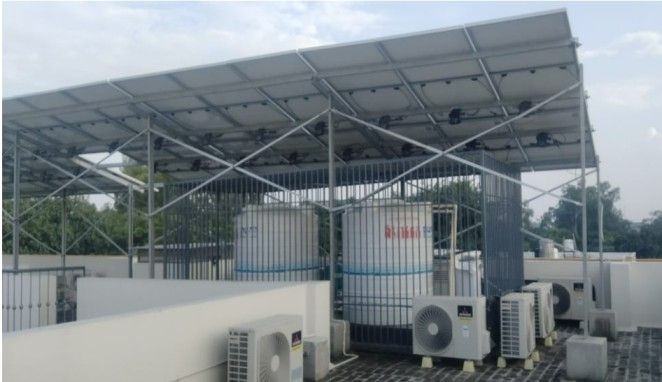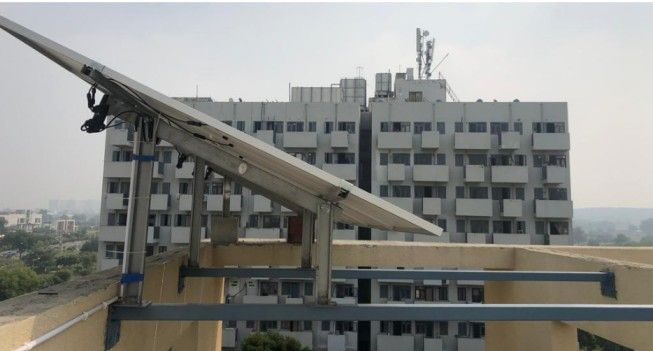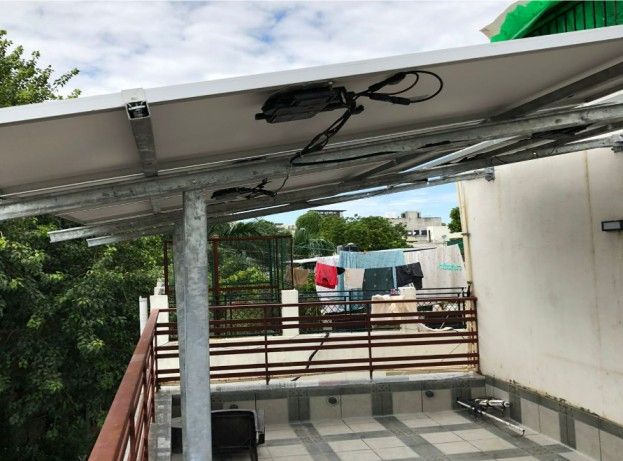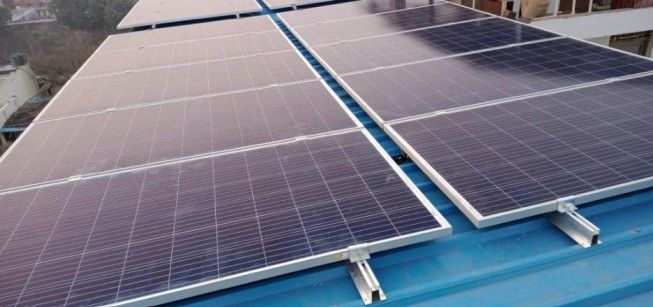One of the key elements involved in setting up an efficient solar system is mounting structure. Module mounting structure(MMS), as the name suggests, is used to hold modules firmly to the surface of installation. Therefore, it is necessary to choose the best quality and the correct type of structure.
Choosing the perfect mounting structure for a rooftop solar plant is not an easy task as it requires careful consideration of all the factors like design, output and durability. It must be strong enough to bear strong winds and keep your system stable.
For selecting the correct type of module mounting structure, one must have a clear idea of their project requirements and then make an informed decision based on that.
Sunson Energy provides the best quality of structure that will cater all your requirements.
Following are the types of structures that we have used for our projects.

In a fixed mount type of structure, the panels are tilted at a fixed angle. They are appropriate for sites with roofs that are flat, easily accessible and well-ventilated. Fixed mounts are the most common way to mount solar arrays on site. The solar panels are installed at a height of 1m from the ground.

The elevated design structure, also known as the high-rise structure, offers improved solar efficiency in a limited roof space. The solar panels are installed at a height of 1.8m to 2.5m from the ground. This is an ideal choice for use of small roofs with limited rooftop space. The other advantages include, one can create a rooftop garden under these panels. This design is also beneficial if you want to keep your tank water cool.

This type of structure is best suited to low-rise buildings. The solar PV modules are installed on the rooftop and with the lowest point of the panel at ground clearance less than 1m. This type of structure minimizes the usage of metal – which results in a lower cost. Because of its low height, this structure has very little wind loading, resulting in a favorable power performance throughout the year.

Structures of this type are usually used in situations where there is a lack of space on the roof. They resemble elevated structures. An elevated structure differs only in its back leg. Elevated structures have back legs. This type of structure does not have a back leg, and the back is supported by a wall.

If you’re looking for a solar installation that offers the same energy savings but without the hassle of cutting holes in your roof, a ballasted mount is right for you. These systems sit directly on top of your home or business and use concrete blocks to secure themselves to the surface. But this system is suitable only when you have a large roof area and you don’t want to use it for other purposes. This type of structure requires a lot of surface area for the installation.

Solar structures that are east-west oriented take advantage of the ability to install a higher density of solar modules, and therefore generate more energy. By creating a pitched structure by laying two panels into a row, there are fewer aisles between panels on a site, allowing more rows to fit while occupying the same footprint. This means that east-west racking models can create blocks with consecutive panel rows in order to recover any power loss incurred by their orientation.
The lower angle of the consecutive modules, combined with the shorter height of these panels, allows the wind to pass over and through the array.

This is one of the most common roof mounted structures of all. It consists of attaching a set of rails to the rooftop. Each solar panel is then attached to the rails through a set of clamps. The rails are secured to the rooftop by screws and bolts. This type of mounting is used when a solar panel is installed on a tilted roof. The tilt at which the solar panels will be placed will be similar to the tilt angle of the roof with a minimum clearance of 0.1m.
Depending on the rooftop area and requirements, one can choose the type of solar structure design.
With these solar structure designs, you can use the space as you like. You can use the space under the solar panels for commercial purposes or for recreational purposes.
All the design structures shown above are installed by us on different projects. The home owners prefer elevated structures as they can use their rooftop for solar as well as use the roof for other purposes. Also, with this type of structure the obstacles on the roof could easily be avoided. For commercial buildings, if the roof is clear of obstructions, the client prefers to install ballast type structures. This has a very low structure cost, therefore the cost of the project is reduced.
If you are still unsure which solar energy structure you should choose, you can always contact us. Our technical team will be happy to assist you in finding a solution that meets your requirements.
One of the key elements involved in setting up an efficient solar system is mounting structure. Module mounting structure(MMS), as the name suggests, is used to hold modules firmly to the surface of installation. Therefore, it is necessary to choose the best quality and the correct type of structure.
Choosing the perfect mounting structure for a rooftop solar plant is not an easy task as it requires careful consideration of all the factors like design, output and durability. It must be strong enough to bear strong winds and keep your system stable.
For selecting the correct type of module mounting structure, one must have a clear idea of their project requirements and then make an informed decision based on that.
Sunson Energy provides the best quality of structure that will cater all your requirements.
Following are the types of structures that we have used for our projects.

In a fixed mount type of structure, the panels are tilted at a fixed angle. They are appropriate for sites with roofs that are flat, easily accessible and well-ventilated. Fixed mounts are the most common way to mount solar arrays on site. The solar panels are installed at a height of 1m from the ground.

The elevated design structure, also known as the high-rise structure, offers improved solar efficiency in a limited roof space. The solar panels are installed at a height of 1.8m to 2.5m from the ground. This is an ideal choice for use of small roofs with limited rooftop space. The other advantages include, one can create a rooftop garden under these panels. This design is also beneficial if you want to keep your tank water cool.

This type of structure is best suited to low-rise buildings. The solar PV modules are installed on the rooftop and with the lowest point of the panel at ground clearance less than 1m. This type of structure minimizes the usage of metal – which results in a lower cost. Because of its low height, this structure has very little wind loading, resulting in a favorable power performance throughout the year.

Structures of this type are usually used in situations where there is a lack of space on the roof. They resemble elevated structures. An elevated structure differs only in its back leg. Elevated structures have back legs. This type of structure does not have a back leg, and the back is supported by a wall.

If you’re looking for a solar installation that offers the same energy savings but without the hassle of cutting holes in your roof, a ballasted mount is right for you. These systems sit directly on top of your home or business and use concrete blocks to secure themselves to the surface. But this system is suitable only when you have a large roof area and you don’t want to use it for other purposes. This type of structure requires a lot of surface area for the installation.

Solar structures that are east-west oriented take advantage of the ability to install a higher density of solar modules, and therefore generate more energy. By creating a pitched structure by laying two panels into a row, there are fewer aisles between panels on a site, allowing more rows to fit while occupying the same footprint. This means that east-west racking models can create blocks with consecutive panel rows in order to recover any power loss incurred by their orientation.
The lower angle of the consecutive modules, combined with the shorter height of these panels, allows the wind to pass over and through the array.

This is one of the most common roof mounted structures of all. It consists of attaching a set of rails to the rooftop. Each solar panel is then attached to the rails through a set of clamps. The rails are secured to the rooftop by screws and bolts. This type of mounting is used when a solar panel is installed on a tilted roof. The tilt at which the solar panels will be placed will be similar to the tilt angle of the roof with a minimum clearance of 0.1m.
Depending on the rooftop area and requirements, one can choose the type of solar structure design.
With these solar structure designs, you can use the space as you like. You can use the space under the solar panels for commercial purposes or for recreational purposes.
All the design structures shown above are installed by us on different projects. The home owners prefer elevated structures as they can use their rooftop for solar as well as use the roof for other purposes. Also, with this type of structure the obstacles on the roof could easily be avoided. For commercial buildings, if the roof is clear of obstructions, the client prefers to install ballast type structures. This has a very low structure cost, therefore the cost of the project is reduced.
If you are still unsure which solar energy structure you should choose, you can always contact us. Our technical team will be happy to assist you in finding a solution that meets your requirements.